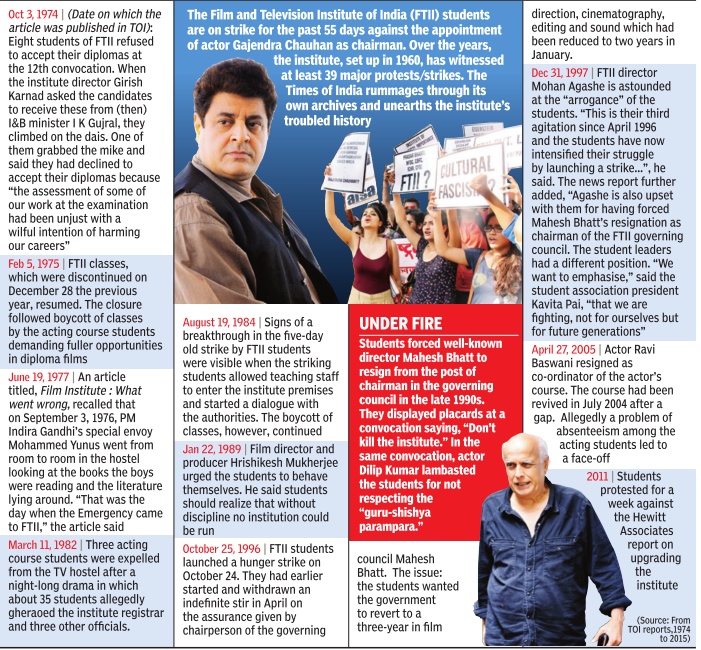Film and Television Institute of India, Pune (FTII)

This is a collection of articles archived for the excellence of their content. |
Contents |
History
1960s: David Lean’s visit
Avijit Ghosh , April 26, 2021: The Times of India
Oscar-winning British film director David Lean visited Pune’s FTII campus in the early 1960s, watched a bunch of short films made by the students and tersely told the teachers, “Something is wrong with your teaching,” reveals a new book brought out to celebrate 60 years of the institution.
The attention-grabbing nugget is part of an article written by Hindi film director Sriram Raghavan (Johnny Gaddar, Andhadhun) following a conversation with actor-director Asrani. Both are FTII graduates. Asrani, who belonged to the first batch, was in the campus when the Oscar-winning director made his visit.
Lean (Lawrence of Arabia) made his remark after noticing that the diploma films made by the students were derivative in nature. “I can tell you which shot is from which German or Czech or French film. You should watch the films of V Shantaram and Bimal Roy too,” he said, according to the article.
For the record, FTII went on to produce many first-rate directors and actors: Adoor Gopalakrishnan, Shaji Karun, Subhash Ghai, Jaya Bhaduri, Shabana Azmi, Naseeuddin Shah, Om Puri, Raj Kummar Rao, to name a few. Raghavan further writes that Lean had come to India on a holiday with his fourth wife Leila Matkar who had relatives in Kolhapur. At that time the sets of Dr Zhivago were being erected in Madrid. “He was dressed in a bush shirt and pants and was wearing Kolhapuri chappals,” Asrani told him. Interestingly, the British filmmaker’s name also figured in the interview of award-winning Malayalam film director Shaji Karun (Piravi). He had applied for a seat in FTII’s cinematography course and was quizzed about his views on the photography in David Lean’s films. “The simple confidence that soon I would be on the train back home gave me the audacity to openly expose my lack of knowledge of the subject,” says Karun self-deprecatingly in the book, “Being FTII: Perspectives on the Film and Television Institute of India.”
He goes on to write, “But also, I was quite baffled when one of them asked me whether I would join the Institute if I got selected. I later came to know that it was the renowned filmmaker Mrinal Sen, the then Chairman of the Selection Committee at FTII who had asked me the question. By late evening, the results were published and my name stood second in the chosen eight.”
Raghavan writes that Lean had come to India on a holiday with his fourth wife Leila Matkar who had relatives in Kolhapur. At that time the sets of Dr Zhivago were being erected in Madrid
Prominent chairmen
The Hindu, October 1, 2015
Anwar Jamal Kidwai (1974 - 1977) First chairman, founder of Mass Communication Research centre at Jamia Millia Islamia.
R.K. Laxman (1977- 1980) Legendary cartoonist, Padma Bhushan, Vibhushan. Known for creating the character "Common Man".
Shyam Benegal (1981 - 1983) (1989 - 1992) Known for pioneering parallel cinema. Recipient of Dadasaheb Phalke Award among others.
Mahesh Bhatt (1995- 1998) Award-winning director, screenwriter, producer in mainstream Hindi cinema.
U.R. Ananthamurthy (2005-2008) (2008-2011) Eminent author, Padma Bhushan. Pioneered Navya movement in Kannada language.
Expenditure per student
The Times of India, Jul 14 2015
Sushmi Dey, Himanshi Dhawan & Akshaya Mukul TNN
Spend on FTII students double of med
The ongoing strike in FTII has brought the focus on the adly-run state of affairs in the premier institute. What comes as a hocker is that with a spending of Rs 12 lakh per student a year, a film tudent is subsidized more than ne studying medicine, management or engineering. The expense on each of the 350 TII students is four times higher than on an IIT student, which is around Rs 3.4 lakh a year. Spend on an IIM student is a shade higher at Rs 5 lakh a year as compared to the IITs.
The Centre's spend on medical education at Rs 6 lakh a year per student is only half the money spent on budding filmmakers. Sources say the government devotes an estimated Rs 30 lakh over 5 years to a student to get an MBBS degree.
The reason for this is the need for an attached hospital for every medical college accompanied with funds to recruit doctors, nursing and other hospital staff that add up to high recurring costs. Besides hospital maintenance, there is significant requirement for chemicals, infrastructure and equipment for medical students to undertake practical sessions.
The subsidy burden for medical education may go up as the Centre plans to expand the number of seats in existing medical colleges such as AIIMS over the next three years. In its defence, FTII can claim to have given the Indian film industry well-known cine matic figures like Shyam Benegal, Raju Hirani and Jahnu Barua among many others.It also adds to the country's soft power to supplement diplomacy .
However, there is a case to be made for effective management of the institute. A cost review by the I&B ministry chief advisor found that the extent of recovery through fees, hostel rent and other expenses as a percentage of expenditure in academic activities in FTII has decreased from 25% in 2006-2007 to as low as 11% in 2010-2011. Add to that the fact that 32 strikes in 50-odd years crippled the organization.
Some of the illustrious alumni have expressed concern over the state of affairs and emphasised that it couldn't be at the cost of the institute itself.